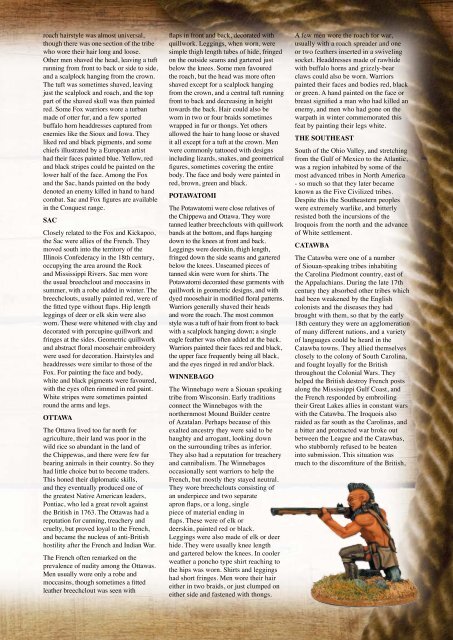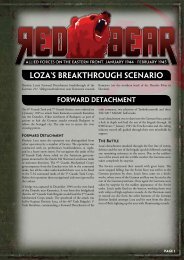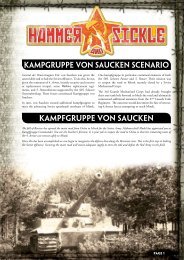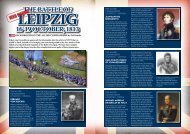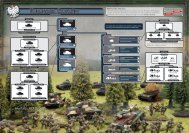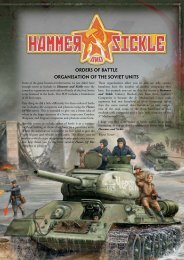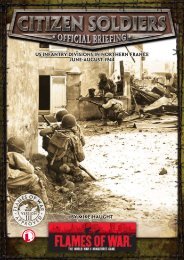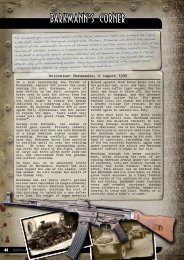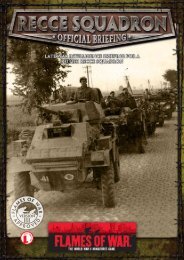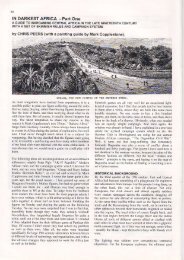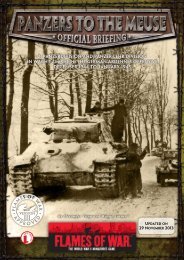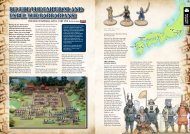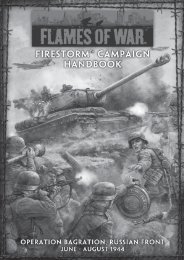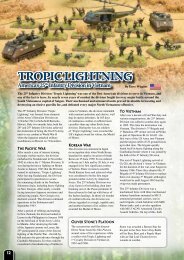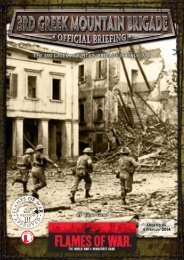INDIAN TRIBES OF THE EASTERN wOODLANDS ... - Flames of War
INDIAN TRIBES OF THE EASTERN wOODLANDS ... - Flames of War
INDIAN TRIBES OF THE EASTERN wOODLANDS ... - Flames of War
Create successful ePaper yourself
Turn your PDF publications into a flip-book with our unique Google optimized e-Paper software.
oach hairstyle was almost universal,<br />
though there was one section <strong>of</strong> the tribe<br />
who wore their hair long and loose.<br />
Other men shaved the head, leaving a tuft<br />
running from front to back or side to side,<br />
and a scalplock hanging from the crown.<br />
The tuft was sometimes shaved, leaving<br />
just the scalplock and roach, and the top<br />
part <strong>of</strong> the shaved skull was then painted<br />
red. Some Fox warriors wore a turban<br />
made <strong>of</strong> otter fur, and a few sported<br />
buffalo horn headdresses captured from<br />
enemies like the Sioux and Iowa. They<br />
liked red and black pigments, and some<br />
chiefs illustrated by a European artist<br />
had their faces painted blue. Yellow, red<br />
and black stripes could be painted on the<br />
lower half <strong>of</strong> the face. Among the Fox<br />
and the Sac, hands painted on the body<br />
denoted an enemy killed in hand to hand<br />
combat. Sac and Fox figures are available<br />
in the Conquest range.<br />
SAC<br />
Closely related to the Fox and Kickapoo,<br />
the Sac were allies <strong>of</strong> the French. They<br />
moved south into the territory <strong>of</strong> the<br />
Illinois Confederacy in the 18th century,<br />
occupying the area around the Rock<br />
and Mississippi Rivers. Sac men wore<br />
the usual breechclout and moccasins in<br />
summer, with a robe added in winter. The<br />
breechclouts, usually painted red, were <strong>of</strong><br />
the fitted type without flaps. Hip length<br />
leggings <strong>of</strong> deer or elk skin were also<br />
worn. These were whitened with clay and<br />
decorated with porcupine quillwork and<br />
fringes at the sides. Geometric quillwork<br />
and abstract floral moosehair embroidery<br />
were used for decoration. Hairstyles and<br />
headdresses were similar to those <strong>of</strong> the<br />
Fox. For painting the face and body,<br />
white and black pigments were favoured,<br />
with the eyes <strong>of</strong>ten rimmed in red paint.<br />
White stripes were sometimes painted<br />
round the arms and legs.<br />
OTTAWA<br />
The Ottawa lived too far north for<br />
agriculture, their land was poor in the<br />
wild rice so abundant in the land <strong>of</strong><br />
the Chippewas, and there were few fur<br />
bearing animals in their country. So they<br />
had little choice but to become traders.<br />
This honed their diplomatic skills,<br />
and they eventually produced one <strong>of</strong><br />
the greatest Native American leaders,<br />
Pontiac, who led a great revolt against<br />
the British in 1763. The Ottawas had a<br />
reputation for cunning, treachery and<br />
cruelty, but proved loyal to the French,<br />
and became the nucleus <strong>of</strong> anti-British<br />
hostility after the French and Indian <strong>War</strong>.<br />
The French <strong>of</strong>ten remarked on the<br />
prevalence <strong>of</strong> nudity among the Ottawas.<br />
Men usually wore only a robe and<br />
moccasins, though sometimes a fitted<br />
leather breechclout was seen with<br />
flaps in front and back, decorated with<br />
quillwork. Leggings, when worn, were<br />
simple thigh length tubes <strong>of</strong> hide, fringed<br />
on the outside seams and gartered just<br />
below the knees. Some men favoured<br />
the roach, but the head was more <strong>of</strong>ten<br />
shaved except for a scalplock hanging<br />
from the crown, and a central tuft running<br />
front to back and decreasing in height<br />
towards the back. Hair could also be<br />
worn in two or four braids sometimes<br />
wrapped in fur or thongs. Yet others<br />
allowed the hair to hang loose or shaved<br />
it all except for a tuft at the crown. Men<br />
were commonly tattooed with designs<br />
including lizards, snakes, and geometrical<br />
figures, sometimes covering the entire<br />
body. The face and body were painted in<br />
red, brown, green and black.<br />
POTAWATOMI<br />
The Potawatomi were close relatives <strong>of</strong><br />
the Chippewa and Ottawa. They wore<br />
tanned leather breechclouts with quillwork<br />
bands at the bottom, and flaps hanging<br />
down to the knees at front and back.<br />
Leggings were deerskin, thigh length,<br />
fringed down the side seams and gartered<br />
below the knees. Unseamed pieces <strong>of</strong><br />
tanned skin were worn for shirts. The<br />
Potawatomi decorated these garments with<br />
quillwork in geometric designs, and with<br />
dyed moosehair in modified floral patterns.<br />
<strong>War</strong>riors generally shaved their heads<br />
and wore the roach. The most common<br />
style was a tuft <strong>of</strong> hair from front to back<br />
with a scalplock hanging down; a single<br />
eagle feather was <strong>of</strong>ten added at the back.<br />
<strong>War</strong>riors painted their faces red and black,<br />
the upper face frequently being all black,<br />
and the eyes ringed in red and/or black.<br />
WINNEBAGO<br />
The Winnebago were a Siouan speaking<br />
tribe from Wisconsin. Early traditions<br />
connect the Winnebagos with the<br />
northernmost Mound Builder centre<br />
<strong>of</strong> Azatalan. Perhaps because <strong>of</strong> this<br />
exalted ancestry they were said to be<br />
haughty and arrogant, looking down<br />
on the surrounding tribes as inferior.<br />
They also had a reputation for treachery<br />
and cannibalism. The Winnebagos<br />
occasionally sent warriors to help the<br />
French, but mostly they stayed neutral.<br />
They wore breechclouts consisting <strong>of</strong><br />
an underpiece and two separate<br />
apron flaps, or a long, single<br />
piece <strong>of</strong> material ending in<br />
flaps. These were <strong>of</strong> elk or<br />
deerskin, painted red or black.<br />
Leggings were also made <strong>of</strong> elk or deer<br />
hide. They were usually knee length<br />
and gartered below the knees. In cooler<br />
weather a poncho type shirt reaching to<br />
the hips was worn. Shirts and leggings<br />
had short fringes. Men wore their hair<br />
either in two braids, or just clumped on<br />
either side and fastened with thongs.<br />
A few men wore the roach for war,<br />
usually with a roach spreader and one<br />
or two feathers inserted in a swiveling<br />
socket. Headdresses made <strong>of</strong> rawhide<br />
with buffalo horns and grizzly-bear<br />
claws could also be worn. <strong>War</strong>riors<br />
painted their faces and bodies red, black<br />
or green. A hand painted on the face or<br />
breast signified a man who had killed an<br />
enemy, and men who had gone on the<br />
warpath in winter commemorated this<br />
feat by painting their legs white.<br />
<strong>THE</strong> SOU<strong>THE</strong>AST<br />
South <strong>of</strong> the Ohio Valley, and stretching<br />
from the Gulf <strong>of</strong> Mexico to the Atlantic,<br />
was a region inhabited by some <strong>of</strong> the<br />
most advanced tribes in North America<br />
- so much so that they later became<br />
known as the Five Civilized tribes.<br />
Despite this the Southeastern peoples<br />
were extremely warlike, and bitterly<br />
resisted both the incursions <strong>of</strong> the<br />
Iroquois from the north and the advance<br />
<strong>of</strong> White settlement.<br />
CATAWBA<br />
The Catawba were one <strong>of</strong> a number<br />
<strong>of</strong> Siouan-speaking tribes inhabiting<br />
the Carolina Piedmont country, east <strong>of</strong><br />
the Appalachians. During the late 17th<br />
century they absorbed other tribes which<br />
had been weakened by the English<br />
colonists and the diseases they had<br />
brought with them, so that by the early<br />
18th century they were an agglomeration<br />
<strong>of</strong> many different nations, and a variety<br />
<strong>of</strong> languages could be heard in the<br />
Catawba towns. They allied themselves<br />
closely to the colony <strong>of</strong> South Carolina,<br />
and fought loyally for the British<br />
throughout the Colonial <strong>War</strong>s. They<br />
helped the British destroy French posts<br />
along the Mississippi Gulf Coast, and<br />
the French responded by embroiling<br />
their Great Lakes allies in constant wars<br />
with the Catawba. The Iroquois also<br />
raided as far south as the Carolinas, and<br />
a bitter and protracted war broke out<br />
between the League and the Catawbas,<br />
who stubbornly refused to be beaten<br />
into submission. This situation was<br />
much to the discomfiture <strong>of</strong> the British,


